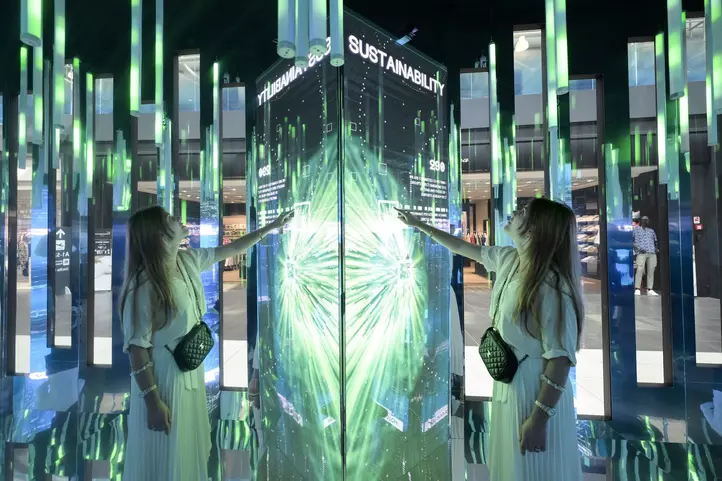A global leader in the financial sphere for decarbonisation projects, a group on course for direct emission reduction targets by 2030, able to speak to the world about innovation and ESG values also through art: Mundys' commitment to sustainability continues on several fronts, including initiatives and confirmations of international calibre, which put the holding company at the forefront of the process of ‘green’ change in air transport, infrastructure and integrated mobility.
A financial guide for sustainability
Mundys will be the corporate leader at the helm of ‘Financing the Airports of Tomorrow’, a pillar of the World Economic Forum and Airport Council International initiative joined by some of the major intercontinental airports (including Aeroporti di Roma and Aéroports de la Côte d'Azur), the aim of which is to identify industrial solutions and forms of hybrid financing that accelerate the green transition of airports, leading to zero emissions by 2050.
The result of Mundys' efforts will be the development of a set of guidelines to finance the decarbonisation in the sector, which will be defined during the project led by the Italian parent company and will be presented during COP 28 in December. The ‘handbook’ will offer innovative solutions to facilitate access to capital by airport companies in order to support investments to fight climate change. These new instruments will involve policy makers and private and public financial institutions (such as the World Bank and the EIB).
Italy will thus play a key role in steering the decarbonisation process of air transport in the WEF initiative, which will study how to transform airports into ‘Energy Hubs’, capable of self-producing, storing and distributing clean energy, and how to contribute to the adoption of SAF on a large scale, using innovative financing instruments, cutting-edge technologies and systems (photovoltaics, storage facilities, electric bollards, Urban Air Mobility, intermodality, etc.).
Best Practices
The leadership of the finance pillar was awarded to Mundys on the basis of the holding company's achievements in sustainable infrastructure management and development and sustainable finance practices. Mundys was one of the first companies in the mobility and aviation sector to adopt a sustainable finance framework, linking financial collection to the industrial and development objectives defined in its Climate action plan.
The parent company also converted its entire bank debt (EUR 3 billion) to ‘green’, the interest rate of which will vary according to the achievement of environmental and social objectives. Aeroporti di Roma, which will support Mundys in drawing up the ‘handbook’, was the first airport management company in the world to issue a sustainability linked bond and a green bond for a total of EUR 800 million to finance its infrastructure projects.
Less emissions: results and targets
The numbers confirm the commitment of Mundys, which has already reduced its direct CO₂ emissions by 26% in 2022 (compared to 2019), with actions for energy efficiency and energy transition: the adoption of LED lighting, the replacement of heating and cooling systems, the electrification of company fleets, and the installation of more than 60 MW of solar systems. Two thirds of the electricity used comes from renewables and airport companies are working towards zero direct emissions already by 2030.
In this regard, SBTi (Science Based Target initiative), an international reference for assessing the decarbonisation targets of companies in line with scientific indications, considered Mundys' targets for direct emission reductions to keep global warming in the 1.5°C trajectory to be adequate. This is the most ambitious target under the SBTi protocol, adopted by only a few industry groups.
In detail, the approved targets (again with respect to 2019) are a 50 per cent reduction in direct emissions across the group by 2030; collaboration with the value chain to reduce indirect emissions: -22% per km travelled on motorways in relation to materials for infrastructure maintenance and operation; -50% of direct emissions of companies in which Mundys has a minority stake; involvement of airlines to set decarbonisation targets.
To date, more than 70 per cent of the materials used for the operation and maintenance of the motorways managed by Mundys are already recovered and feed into circular economy processes, and the managed airports are installing more than 5,000 charging points for electric vehicles.
The Language of Art
In this regard, Mundys has designed another initiative to publicise its network of infrastructure and services, as well as its commitment to sustainability, by involving travellers. For six weeks from 3 August, passengers at Rome Fiumicino's Leonardo da Vinci Airport will be able to enjoy an interactive Data Art experience. The work is entitled ‘Moving Data’ and provides an immersive and engaging experience, designed to communicate sustainability data and targets, through the areas Sustainability, Motorways, Airports, Mobility Services.
The author of the work is Davide Asker who, with the WOA Creative Company team from Milan, has combined technology and creativity to accompany the traveller in a mirrored structure, amid reflections and perspectives that offer the sensation of moving through an infinite and interactive space. Thanks to a skilful use of light design, an emotional soundscape, monitors and Lidar scanners, before their flight, passengers can traverse evocative visual worlds in a relaxing dream space, while experiencing a unique artistic experience in direct contact with the world of Mundys.

